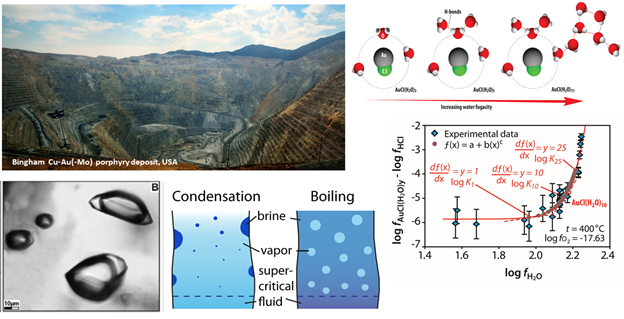Precious vapors: Are vapors viable ore fluids in the context of porphyry ore formation?
Dr. Nicole C Hurtig from New Mexico Tech will present her research at the occasion of her visit as invited researcher within the Metallogeny group.
Jully 6th
14:00
E 018 (amphitheatre)
Zoom

Abstract
Porphyry Cu-Au and Cu-Mo deposits constitute the largest source of Cu and Mo ore worldwide and contain significant resources of Au, W and Ag. They typically form in oceanic and continental arcs above subduction zones where magmas are produced as a result of dehydration of the subducting slab. Ore formation in porphyry systems is controlled by the exsolution of these NaCl-bearing fluids and the formation of magmatic-hydrothermal plumes. Metals such as Cu, Mo and Au partition from the melt into the aqueous saline fluids and are transported to the site of ore deposition. Ore shells form partially overlapping elongated or mushroom-shaped zones surrounded by extensive alteration halos. The high-temperature potassic alteration is preserved in the deeper parts closer to the intrusion and is overprinted by intermediate temperature phyllic alteration upwards and propylitic alteration outwards. Argillic and vuggy silica alteration represent the low-temperature alteration overprint at very shallow levels. Fluid inclusion studies provide evidence for a complex environment of changing fluid phases as a result of pressure fluctuations. The fluid evolution pathways vary in different porphyry systems depending on the depth and timing of fluid exsolution, the composition and volume of the fluids (i.e., salinity, CO2 contents etc.), and the permeability of the host rocks. Ongoing debates revolve around the roles of high-density brines, low-density vapors and single phase fluids for metal transport and precipitation. In this lecture, we will look at examples from natural analogues and new experimental studies to evaluate the importance of low- and intermediate-density fluids for ore formation. The controlling factors of metal enrichment are investigated using numerical simulations to predict metal solubility in magmatic-hydrothermal plumes with pressure fluctuations and transient phase states.



